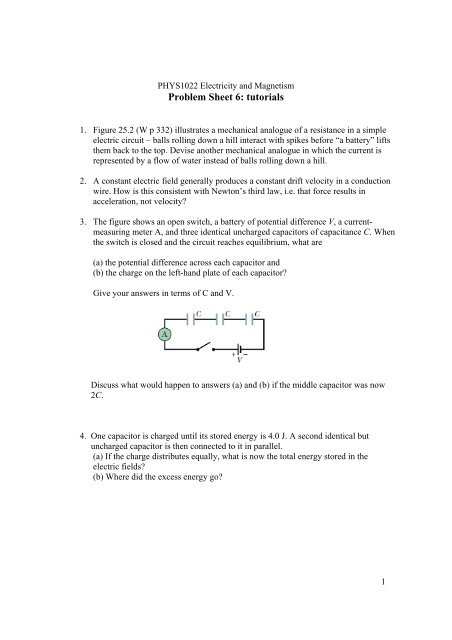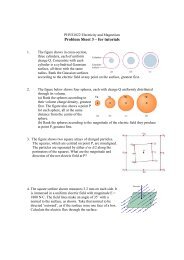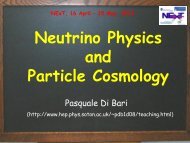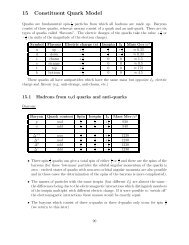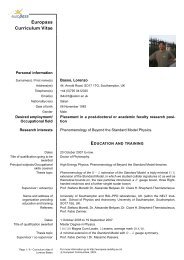Problem Sheet 6: tutorials
Problem Sheet 6: tutorials
Problem Sheet 6: tutorials
- No tags were found...
Create successful ePaper yourself
Turn your PDF publications into a flip-book with our unique Google optimized e-Paper software.
PHYS1022 Electricity and Magnetism<strong>Problem</strong> <strong>Sheet</strong> 6: <strong>tutorials</strong>1. Figure 25.2 (W p 332) illustrates a mechanical analogue of a resistance in a simpleelectric circuit – balls rolling down a hill interact with spikes before “a battery” liftsthem back to the top. Devise another mechanical analogue in which the current isrepresented by a flow of water instead of balls rolling down a hill.2. A constant electric field generally produces a constant drift velocity in a conductionwire. How is this consistent with Newton’s third law, i.e. that force results inacceleration, not velocity?3. The figure shows an open switch, a battery of potential difference V, a currentmeasuringmeter A, and three identical uncharged capacitors of capacitance C. Whenthe switch is closed and the circuit reaches equilibrium, what are(a) the potential difference across each capacitor and(b) the charge on the left-hand plate of each capacitor?Give your answers in terms of C and V.Discuss what would happen to answers (a) and (b) if the middle capacitor was now2C.4. One capacitor is charged until its stored energy is 4.0 J. A second identical butuncharged capacitor is then connected to it in parallel.(a) If the charge distributes equally, what is now the total energy stored in theelectric fields?(b) Where did the excess energy go?1
PHYS1022 Electricity and Magnetism<strong>Problem</strong> <strong>Sheet</strong> 6 - workshop1 A 100-pF capacitor and a 400-pF capacitor are charged to 1 kV and 2 kVrespectively. They are then disconnected from the voltage source and are connectedtogether, positive plate to positive plate, and negative plate to negative plate.(a) Find the resulting potential difference across each capacitor.(b) Find the energy lost when the connections are made.2. A uniformly charged thin ring has radius 15.0 cm and has total charge +24.0 nC. Anelectron is placed on the ring’s axis a distance 30.0 cm from the centre of the ring andis constrained to stay on the axis of the ring. The electron is then released from rest.(a) Derive an expression for the potential along the axis due to the charged ring. Draw asketch of this function, and a sketch of the potential energy of the electron.(b) Describe the subsequent motion of the electron by sketching its position along theaxis as a function of time.(c) Find the speed of the electron when it reaches the centre of the ring.3. Show that the electric field for an infinitely long, uniformly charged cylindrical shell ofradius R carrying a surface charge density σ is given byE r = 0 for r < RR r 2 r0E r 0for r > Rwhere λ = 2πRσ is the charge per unit length on the shell.2


